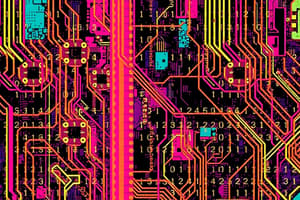Podcast
Questions and Answers
Which of the following registers can be used to access memory?
Which of the following registers can be used to access memory?
- BX (correct)
- AX
- CX
- DX
The segment register used by default for all modes except those with BP register is SS.
The segment register used by default for all modes except those with BP register is SS.
False (B)
What does d8 stand for in memory access?
What does d8 stand for in memory access?
8-bit signed immediate displacement
The value in a segment register (CS, DS, SS, ES) is called a _______________.
The value in a segment register (CS, DS, SS, ES) is called a _______________.
Match the registers with their usage in memory access:
Match the registers with their usage in memory access:
What is the physical address calculated by the processor for the addressing mode [BX + SI] + 25, assuming DS = 100, BX = 30, SI = 70?
What is the physical address calculated by the processor for the addressing mode [BX + SI] + 25, assuming DS = 100, BX = 30, SI = 70?
BX and BP can be used together in an addressing mode.
BX and BP can be used together in an addressing mode.
The value in a general-purpose register (BX, SI, DI, BP) is called a _______________.
The value in a general-purpose register (BX, SI, DI, BP) is called a _______________.
What is the physical address when DS contains the value 1234h and SI contains the value 7890h?
What is the physical address when DS contains the value 1234h and SI contains the value 7890h?
The MOV instruction can be used to set the value of the CS and IP registers.
The MOV instruction can be used to set the value of the CS and IP registers.
What is the purpose of the prefixes 'byte ptr' and 'word ptr' in assembly language?
What is the purpose of the prefixes 'byte ptr' and 'word ptr' in assembly language?
If zero is added to a hexadecimal value, it is multiplied by _______.
If zero is added to a hexadecimal value, it is multiplied by _______.
Match the following prefixes with their data types:
Match the following prefixes with their data types:
What is the purpose of the MOV instruction in assembly language?
What is the purpose of the MOV instruction in assembly language?
The assembler can always calculate the data type automatically.
The assembler can always calculate the data type automatically.
What is the format of the physical address when DS contains the value 1234h and SI contains the value 7890h?
What is the format of the physical address when DS contains the value 1234h and SI contains the value 7890h?
Flashcards are hidden until you start studying
Study Notes
Memory Access
- Four registers can be used to access memory: BX, SI, DI, and BP.
- Combining these registers inside square brackets
[ ]allows accessing different memory locations. - Supported addressing modes include:
- [BX + SI]
- [BX + DI]
- [BP + SI]
- [BP + DI]
- [SI]
- [DI]
- d16 (variable offset only)
- Displacement can be:
- 8-bit signed immediate (d8)
- 16-bit signed immediate (d16)
- Immediate value or offset of a variable, or both
- Inside or outside the
[ ]symbols
- Displacement is a signed value, allowing positive or negative values.
Segment Registers and Offset
- Segment register values (CS, DS, SS, ES) are called segments.
- General-purpose register values (BX, SI, DI, BP) are called offsets.
- Segment:offset notation is used to represent the combination, e.g., 1234:7890.
Data Type Prefixes
- Prefixes are used to specify data type:
- byte ptr - for byte
- word ptr - for word (two bytes)
- Shorter prefixes are also supported:
- b. - for byte ptr
- w. - for word ptr
- Assembler can calculate data type automatically in certain cases.
MOV Instruction
- Copies the second operand (source) to the first operand (destination).
- Source operand can be:
- Immediate value
- General-purpose register
- Memory location
- Destination register can be:
- General-purpose register
- Memory location
- Both operands must be the same size (byte or word).
- Supported types of operands include:
- MOV REG, memory
- MOV memory, REG
- MOV REG, REG
- MOV memory, immediate
- MOV REG, immediate
Studying That Suits You
Use AI to generate personalized quizzes and flashcards to suit your learning preferences.




